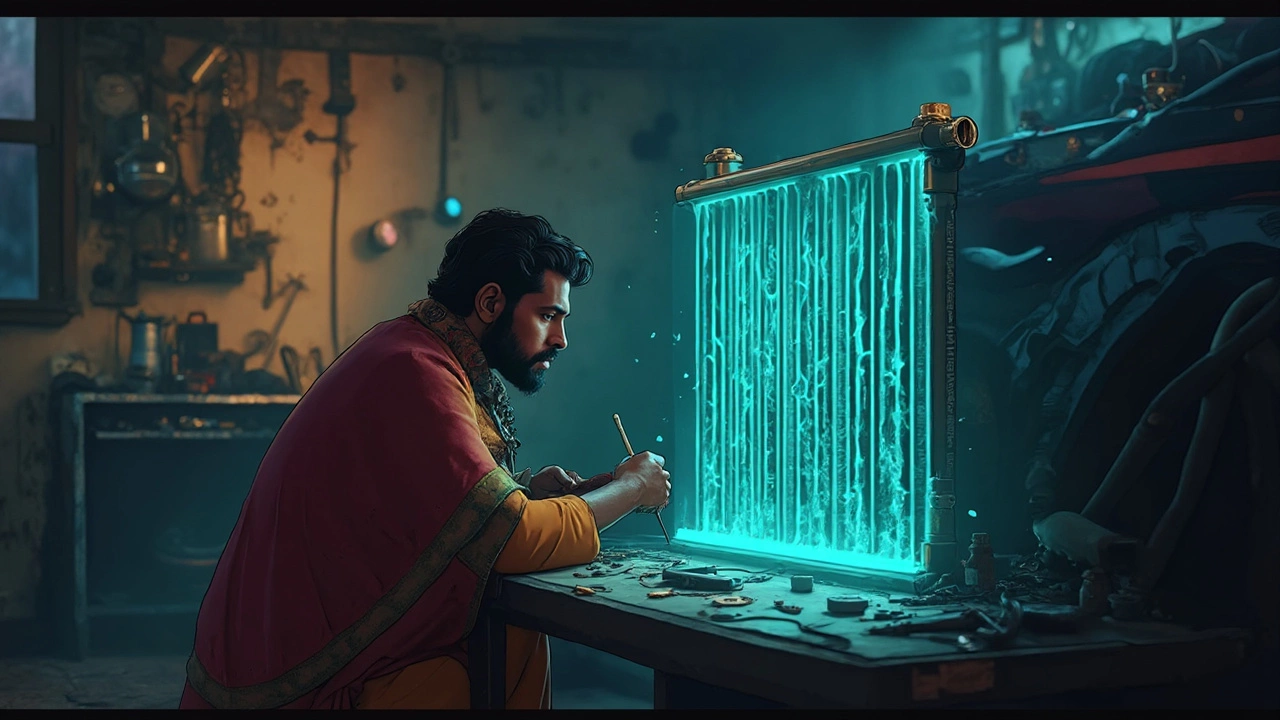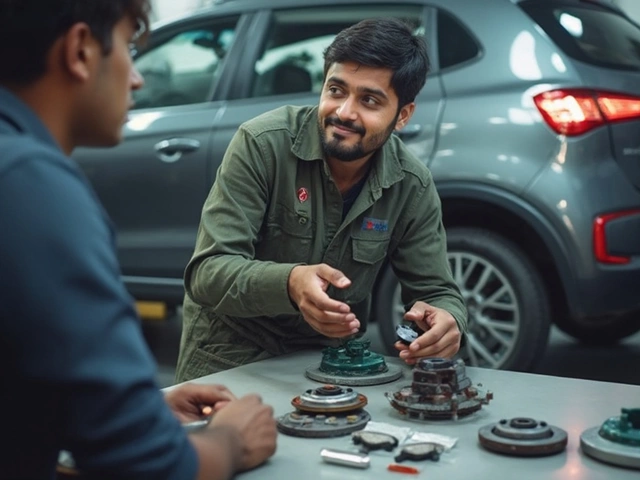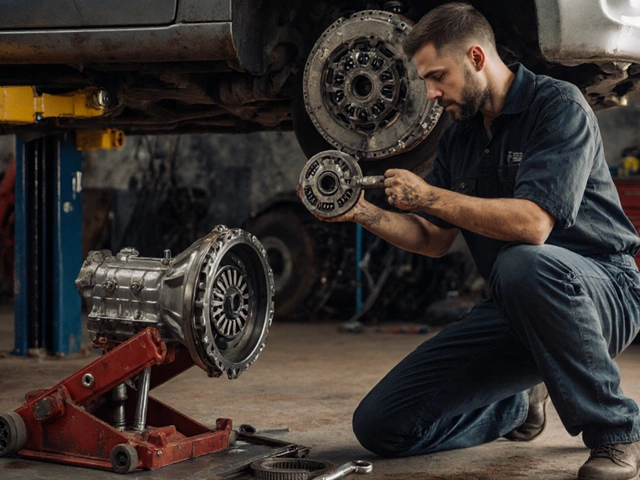
If you've ever been curious about what exactly keeps your car from overheating on those hot summer days, the answer is pretty simple: the radiator. It's a crucial part of your car's cooling system, making sure that your engine stays at the right temperature. But how does this all work? And what should you know to keep it in top shape?
A car radiator's main job is to transfer heat from the engine to the air outside, keeping things from getting too toasty under the hood. It works along with the engine's cooling system, which includes coolant, hoses, and a thermostat, to circulate and cool the fluid that flows around the engine.
The coolant absorbs the heat, moves to the radiator, and as it flows through a series of thin pipes, the heat dissipates into the air thanks to the radiator's design. So, maintaining a healthy radiator isn't just about avoiding overheating; it's about optimizing engine performance and efficiency.
- The Role of the Car Radiator
- How Radiators Work
- Signs of a Failing Radiator
- Radiator Maintenance Tips
- Choosing the Right Radiator
- Common Myths About Car Radiators
The Role of the Car Radiator
At its core, the car radiator serves as the regulator of your engine's temperature. It's sort of like the unsung hero under your hood, effectively keeping the engine cool and running smoothly by preventing overheating, which can lead to significant damage if left unchecked.
Why Cooling is Critical
The engine is the hotbed of activity in your vehicle. As you drive, the engine's combustion process generates a lot of heat, and that's where the cooling system steps in. If this heat isn't efficiently dissipated, you risk damaging vital components, leading to expensive repairs or even total engine failure.
How the Radiator Works
The radiator's job is to transfer heat away from the coolant circulating through the engine. Think of it as a kind of heat exchanger, where the coolant that collects heat from the engine flows through the radiator. Air passing over the radiator fins cools the fluid before it's sent back to the engine to repeat the cycle.
A common type you might encounter is the crossflow radiator, designed with tubes placed horizontally which help maximize the cooling area. But regardless of the design, all radiators fundamentally accomplish the same task—maintaining a stable engine temperature for optimal performance.
The Cooling System Symphony
The radiator doesn't work alone. It's part of a bigger ensemble that includes a water pump, thermostat, and cooling fan. These components work in unison to control the engine temperature, pushing the coolant through the engine and onto the radiator.
Fun Fact
Did you know that even modern racing cars have advanced radiators designed for incredibly high heat performances? These radiators must disperse significant heat loads effectively without adding unnecessary weight to the car.
Ultimately, understanding the role of your car radiator helps you appreciate why its upkeep is important. Recognizing when there's a problem can save you a lot of hassle (and cash) down the road.
How Radiators Work
Ever wonder what keeps your engine at a manageable heat level? The radiator is the unsung hero doing the heavy lifting here. It's right there at the front of your car and acts as the gateway to keeping the engine cool. To get to the nuts and bolts of it, let's break down how radiators work in the most straightforward way.
Coolant's Journey
First off, there's this magical liquid we call coolant. It's usually a mix of water and antifreeze. The primary role of coolant is to absorb engine heat, and then travel with this absorbed heat to the car radiator. Once it reaches the car radiator, a whole science-y heat exchange process happens.
As the coolant flows through the narrow tubes within the radiator, the heat it carries gets transferred to the radiator's metal fins. The design of these fins increases the surface area, effectively helping heat dissipate faster into the surrounding air. It’s really all about maximizing contact with the cooling air that flows past as you drive, or from the cooling fan that kicks in when you're stationary.
Air Flow and Fans
Of course, airflow plays a huge role here. When your vehicle is speeding down the road, air naturally flows through the grille, enhancing the radiator's cooling capabilities. But what about sitting in traffic? That's where the fan comes in. Whether it's engine-driven or electric, the fan ensures there's always enough air moving through the radiator to support cooling.
Little Details, Big Impacts
There are a few more components of a cooling system that interact with the radiator. For instance, we have the thermostat. This handy device controls when the coolant flows based on the engine's temperature. Then there's the pressure cap, which maintains the right pressure to raise the boiling point of the coolant, making sure it stays liquid, even when the engine runs hot.
Efficiency and Innovations
Today's radiators are more efficient than ever, thanks to advancements in materials and design. Aluminum is commonly used due to its excellent heat conduction and lightweight properties. There's always room for improvements and new tech popping up, focusing on efficiency and eco-friendliness.
| Component | Function |
|---|---|
| Coolant | Absorbs engine heat |
| Radiator | Dissipates heat into air |
| Fan | Maintains air flow |
| Thermostat | Regulates coolant flow |
By understanding how the radiator works, you can appreciate its vital role in the safe and efficient running of your engine. Keep it handy when you think about your car's health!
Signs of a Failing Radiator
Keeping an eye on your car's radiator is smart because catching problems early can save you a lot of hassle. If your car radiator is on the fritz, your engine might be at risk of overheating, and that's the last thing you want. So, what are the telltale signs?
1. Overheating Engine
One of the most obvious signs is the temperature gauge rising or the warning light coming on. If you notice the gauge creeping into the red zone, your radiator might not be doing its job.
2. Coolant Leaks
Spotting a puddle under your car? That's often coolant, and it could mean a leaky radiator. Check for a sweet smell or visible green, yellow, or orange fluid, which indicates a coolant leak.
3. Discolored or Sludgy Coolant
Healthy coolant is usually bright and clear, like Kool-Aid. If it looks rusty or like thick sludge, it might mean internal corrosion in the radiator.
4. Low Coolant Levels
Frequent topping off of coolant could suggest a problem. Where is it going? A crack in the car radiator could be the culprit.
5. Radiator Fins Blocking
Dust, debris, or insects can lodge in the radiator fins. Take a look and clean them out if necessary because those little fins are crucial for dissipating heat.
- Check for visible obstructions.
- Rinse with water to remove dirt.
Not all symptoms mean that the radiator is at fault, but they are good indicators that something's off with the cooling system. And hey, if you're not comfortable checking these yourself, it's okay to visit a mechanic. Better safe than sorry!

Radiator Maintenance Tips
Keeping your car radiator in tip-top shape is key to a healthy engine life. It's not all that complicated, but it does require a bit of regular attention. Here's how you can take care of your radiator and avoid bigger problems down the road.
Check Your Coolant Levels
Believe it or not, something as simple as checking your coolant levels on a regular basis can prevent overheating. The coolant should always be at the right level; the sweet spot is usually somewhere between the 'min' and 'max' markers on the reservoir. If it's consistently on the low side, you might have a leak that needs fixing.
Flush the Radiator
Flushing the radiator can clear out any gunk or rust that builds up over time. It's generally a good idea to do a radiator flush every 30,000 miles or so, but always check your car's manual for specific recommendations. The process involves draining old coolant and cleaning the system before filling it with new coolant.
- Buy a radiator flush solution and follow the instructions on the label.
- Empty the radiator, add the flush solution, and then run the engine for a bit to circulate the cleaner.
- Once the system is clean, refill it with the right mix of coolant and water.
Inspect the Radiator and Hoses
A quick look under the hood can reveal cracks or wear in the hoses. These parts endure a lot of wear and tear due to the high temperatures and pressure they face. If you spot any signs of damage, it's best to replace the part sooner rather than later to prevent leaks or bursts.
Keep an Eye on the Temperature Gauge
Always pay attention to the temperature gauge on your dashboard. If it starts creeping into the red zone, pull over and give the engine some time to cool off. Driving with an overheating engine can do a ton of damage.
Regular Inspections
If you're not a DIY kind of person, no worries. Just make sure that whenever your car is in the shop for other things, you ask to have the radiator and cooling system checked as well. A professional can catch problems early, saving you from more expensive repairs later on.
| Maintenance Task | Recommended Frequency |
|---|---|
| Coolant Check | Every Month |
| Radiator Flush | Every 30,000 miles |
| Hose Inspection | Every 12 months or with oil change |
| Full System Inspection | With every mechanic visit |
Remember, a little attention goes a long way in keeping your car running smoothly. Taking care of your radiator today can save you from a world of trouble — and big bills — down the line.
Choosing the Right Radiator
Picking the right car radiator isn't as daunting as it sounds, but it does require some know-how. Whether you're replacing an old one that's seen better days or upgrading, it's crucial to select a radiator that suits your car's needs.
Consider Your Driving Needs
First things first, think about how you use your car. If you're just cruising around town, a standard radiator should do the trick. But if you're big on towing heavy loads or love hitting the track for some fun, you might need something beefier, like a high-performance radiator.
Material Matters
Radiators come in different materials with aluminum and copper-brass being the most common. Aluminum radiators are lightweight and offer excellent cooling efficiency, which is why they're popular in many modern cars. Copper-brass radiators cool well but are generally heavier, making them a bit of a trade-off between cooling and weight.
Size and Fit
Size matters—a radiator that's too big or too small won't fit correctly or perform well. Always check your car's manual or consult with a professional to ensure you're getting the right dimensions. Getting the right size makes installation easier and ensures optimal cooling.
Core Count
Take a look at the core count of a radiator. More cores generally mean better cooling since there’s more surface area to dissipate heat. However, more cores can also mean more weight, so you have to balance cooling needs with vehicle performance.
Budget
We all have budgets to stick to, right? Thankfully, there's a radiator for almost every budget. Just remember that often, you get what you pay for. While saving a few bucks might feel good now, you don't want to compromise too much on quality, especially for something as critical as your car’s cooling system.
- Match the radiator with your specific vehicle model.
- Consider engine size and type.
- Think about your climate—hotter areas might require better cooling capacity.
A well-chosen radiator ensures your engine runs smoothly, keeping you worry-free when you're out and about. After all, no one enjoys being stranded with a steaming engine!
Common Myths About Car Radiators
It's easy to get tangled up in misinformation when it comes to car maintenance. Radiators, in particular, have their fair share of myths that can lead owners astray. Let's clear up some common misconceptions and get straight to the facts, helping your car radiator do its job effectively.
Myth #1: Coolant Doesn't Need to be Replaced
Some folks believe that once you've filled the coolant, it's good for life. Not true! Over time, coolant can become contaminated or lose its effectiveness. Regularly checking and replacing it as per your vehicle's manual is key to avoiding radiator problems.
Myth #2: Water Can Replace Coolant in a Pinch
Sure, water might work temporarily if you're stuck, but it's not a long-term solution. Coolant not only prevents overheating but also protects against freezing and corrosion. Water just can't do all that a proper coolant mix can. Stick with the right stuff for your cooling system.
Myth #3: Leaky Radiators Can Be Ignored
People often think a small leak won't hurt. A leak can lead to significant issues if ignored, like engine overheating or damage. Spotting and fixing leaks early is crucial.
Myth #4: All Radiators Are the Same
Many assume a radiator is just a radiator, but there are differences based on materials and build quality. Choosing the right radiator for your model and make is essential for optimal performance.
Understanding these myths helps you take better care of your radiator and, in turn, your entire engine. Keep your radiator in check and avoid falling for these common myths!





